I have to admit that I’ve had a beef with Remington lately. After being totally disappointed with an 887 Nitro Mag, seeing numerous QC issues with Model 700 rifles –including an problem a fellow TTAG writer had – having an issue with a 700 myself, then seeing a brand-new 870 lock up on the first trip to the range, I had pretty much written Remington off as a once-legendary manufacturer that had fallen prey to the “throw QC out the door to save $0.06” monster. But at the same time, I love Remington. I used an 870 20-gauge pump for a decade on pheasant, grouse, and dove. Half of my safe is devoted to Remington Model 700s that are over two decades old. Most shoot just as well now as they did when they were new. When I turned 16, my dad gave me his fancy-grade M700 CDL chambered in .30-06. I was as proud as a peacock the first day I showed up at the range with that baby…
With those fond memories of a highly polished, deep blued barreled and fine-grade walnut stocked CDL in mind, I decided that I’d give Remington one last shot at keeping me as a customer. I’ve wanted a heavy-barreled .30-caliber rifle and when I laid eyes on the XCR Tactical Long Range (TLR), I just had to have it. I made some calls, laid up my credit card, and waited for my new rifle to arrive. It didn’t take long since Davidson’s is in Prescott, AZ — a mere three-hour drive from my doorstep.
Although not a wood-stocked beauty, the TLR is attractive in its own way. The factory installed Bell & Carlson stock is olive drab with a black webbing overlay. Bell & Carlson calls this stock a “Light Tactical” model and features a full-length aluminum bedding block, an extended grip and a fairly wide fore-end with dual front sling studs to allow for both bipod and sling attachment. The stock also features a recessed “thumbhook” behind the pistol grip for off-the-bench shooting performance and helps “lock” the rear of the stock with shooting prone or off the bench.
Like all of Remington’s Extreme Conditions Rifles (XCR), the TLR is made of 416 stainless steel. To further enhance the corrosion resistance of the action and barrel, Remington applies their TriNyte finish, a PVD (physical vapor deposition) process that hardens and smoothes the surface. The heavy-contoured 26” fluted barrel is sharp and certainly looks the “tactical” part. It’s free-floated and the fluting includes three deep flutes (120 degrees apart) like Remington’s Light Tactical Rifle (LTR) lineup.
The barrel features a 1:12” twist rate, something I was surprised to see, particularly since this rifle is billed as “tactical.” Most tactical .308 caliber rifles feature a 1:10” twist rate, designed to stabilize heavier (160-grain and up) bullets. The barrel is finished off with a dished-out target crown.
One of the biggest selling points for me was the factory installed 40-X trigger. The 40-X has been around for decades and normally is only available as an aftermarket part or from Remington’s custom shop. It’s externally adjustable and can be set down all the way to 1.5lbs for those who like to fire their gun by blowing on it. I used my new Lyman Electronic Trigger Pull Gauge and out of the box, my TLR was set to 4 lbs-2 oz and had a 10-pull standard deviation of 4.2 oz. While the market is full of high-quality aftermarket adjustable triggers for the Remington 700, some still argue that the 40-X is the best Remington trigger available.
Not so fast…
Before I could go to the range, there were a few things that needed to be done. First, the Model 700 XCR doesn’t come with any sights, not that you’d expect it to. Few people relate “open sights” with “tactical.” Anyway, I needed to pick some quality glass to match (what I hoped would be) the quality of this rifle. I toyed with the popular options: NXS, Leupold Mark IV, US Optics, and the like.
I eventually placed my order with Brownell’s for a Trijicon Accupoint 5-20x50mm (TR23-2G Model#) with a mil-dot reticle and green dot. Why the Trijicon? Well, I’ve used Trijicon scopes in the past (both the ACOG and Accupoint 3-9x) and had nothing but the best of luck with them. As a matter of fact, I plan on purchasing another one (2.5-10x) for Project Elk Slayer when funds become more plentiful (man the holidays are rough!)
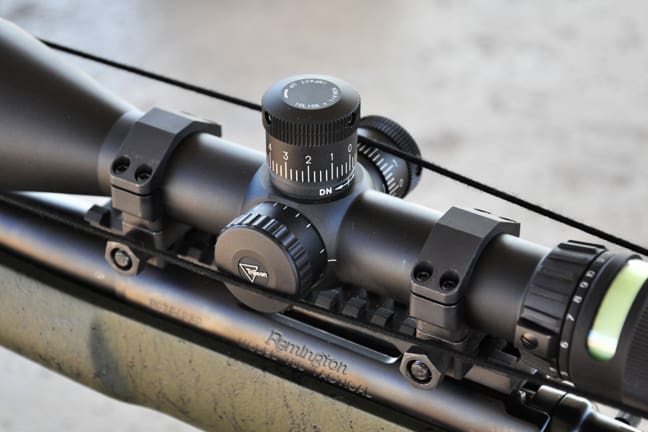 Trijicon Accupoint TR23-2G installed with Badger Maximized base and rings
Trijicon Accupoint TR23-2G installed with Badger Maximized base and rings
Some 1000-yard guys will say that the Trijicon Accupoint isn’t a true 1000-yard scope, and I’d have to agree. There’s only 40 MOA of internal adjustment, meaning that unless you install a 20 MOA base, you’ll likely run out of “clicks” before you hit that 1000-yard zero sweet spot. Currently, I’m not shooting for score, so I tend to use the hold-over method and thus internal adjustments don’t mean much to me. However, the reticle is thick enough to block fine/small targets past the 600-yard mark.
On the other hand, there are reports circulating that Trijicon sources the glass used in Accupoint scopes from the same supplier Nightforce uses on their NXS line. While not the first choice for benchrest shooters, Accupoint scopes have their following with the varmint popping and hunting crowds. The TR23-2G is a solid hunk of scope, has an illuminated aiming dot that doesn’t require batteries and a very usable mil-dot reticle – something even the snobbiest benchrest shooter can appreciate. Keep an eye out in our “Gear Review” section for a full review and write-up.
Wanting to keep with the tactical theme as much as possible, I decided that heavy-duty rings and a solid single-piece base was just the setup this gun needed. I ended up ordering a set of standard-height Badger Maximized scope rings and a Badger Maximized Scope Rail to keep the near 27 oz. Accupoint locked solidly in place. Badger makes incredibly strong products — so strong in fact that the U.S. Military uses Badger rings and trigger-guard metal on the M40A3/A5 variants.
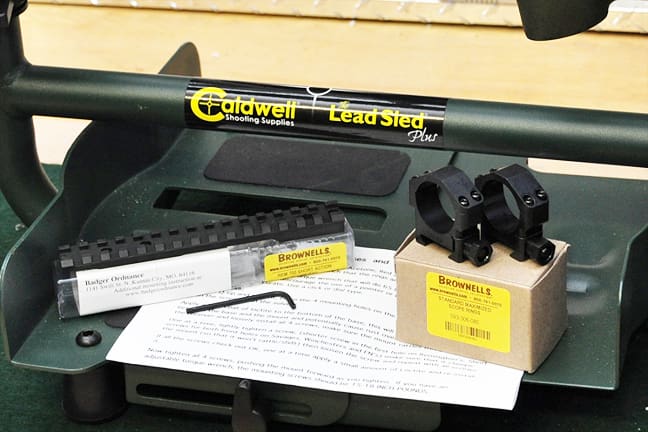 Getting ready to install the Badger Maximized scope base and rings
Getting ready to install the Badger Maximized scope base and rings
The Badger scope base features a heavy steel base with a 20 MOA cant designed to maximum scope elevation for long-range shooting. Like most Badger accessories, the scope base is machined after hardening to maintain dimensions. The base also features an integral recoil lug designed to withstand the hardest kicking calibers and uses a MIL-STD 1913 Picatinny slot pattern for maximum scope-mounting options.
Badger rings are machined from steel barstock as serialized matched pairs. This assures that both rings are identical and eliminates the damaging effects of mismatched, mass-produced rings. If you need an extra paper weight in your home office, a Badger ring will work just fine. They’re heavy, have an attractive mil-spec black oxide finish, and are close to overkill for a .308. Perfect.
Since all of my other bipods already have homes, I decided to keep the UPS guy busy and placed my order for a new Harris HBRS model and an E. Arthur Brown S-Lever to replace the OEM knurled knob on the Harris. The Harris HBRS has 6 to 9 inches of height adjustment and features a swivel base to allow for quick and easy leveling on uneven terrain. It’s designed for benchrest shooting, but I find it very comfortable when shooting prone as well. The EAB S-lever simply screws in place of the OEM swivel adjustment knob and gives you a faster and more convenient way to tighten and secure the rifle in place.
 Harris HBRS Bipod w/EAB S-Lever
Harris HBRS Bipod w/EAB S-Lever
At the bench…
Time to make this big lady sing. Or at least get her sighted in. I grabbed some cheap 150-grain Winchester soft-point ammo to test the action and get the scope on paper. I was also able to find a box of American Eagle 168-grain OTM (open tip match) ammo (PN: A76251M1A) designed for M1A use. I got on the paper quickly, but I was far from happy. I was only able to maintain 2- to 3-inch groups — certainly not what I was expecting from this rifle.
Then, when I opened the box of American Eagle OTM ammo the planets aligned, the tides swelled, and all was right with the world. The first five shots resulted in an impressive 0.63-inch grouping. Other groupings were decent, but none were as good as than the first. I packed up everything and headed home with a grin. I set the POI to be 1.3 inches high at 100-yards and “reset” the turrets to zero with the supplied Allen key.
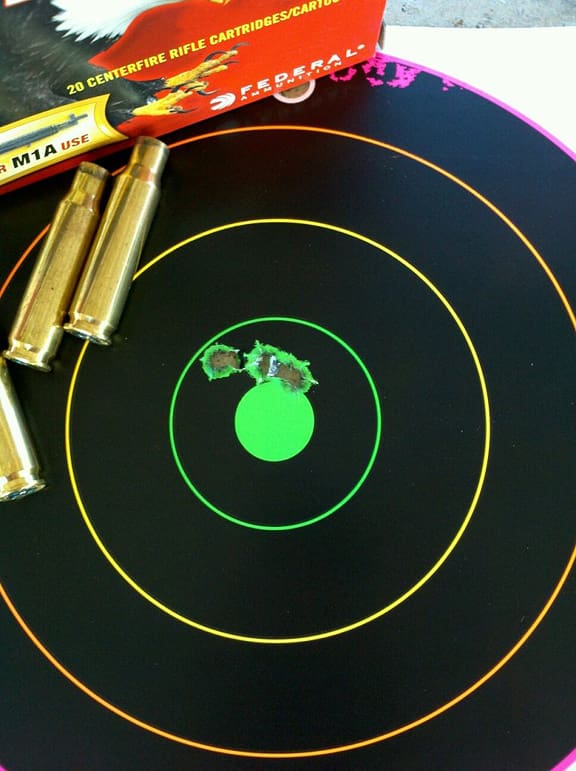 First 5-shot group with American Eagle OTM 168-gr
First 5-shot group with American Eagle OTM 168-gr
Wanting to see if I could improve on the first grouping, I did some intertube research to find what loads have proven the best for this length barrel and twist rate. Then I went to the Brownell’s website and picked out a half-dozen loads that were known performers. A week later, after a visit from the Big Brown Truck, I was ready to head back to the range.
I picked a few rounds of “match”-grade hunting ammo, as well as a few true match-grade target rounds. Since this is a heavy barrel gun, I decided to shoot five-round groups and to use all five rounds for group size calculation. This is a slight change from my “shoot five, count four” approach, but this gun should have no problem dishing out tight five-shot groupings.
I still followed my standard testing method of allowing the barrel to completely cool between groups. I also pulled a dry Bore-snake through the barrel between groupings to make sure residual carbon didn’t impair subsequent groupings. One hour and a very sore shoulder later, I was finished with 100-yard testing. The results are as follows:
|
.308 Win Ammo – 100 yards |
Group Size (in) |
|
Remington Premier MatchKing 168-gr |
0.32 |
|
American Eagle 168-gr OTM |
0.63 |
|
Hornady Custom 165-gr BTSP |
0.94 |
|
Hornady Match 168-gr BTHP |
1.07 |
|
Federal Gold Medal Match 168-gr |
1.19 |
|
Hornady A-Max 168-gr (repeat) |
1.44 |
|
Federal Gold Medal Match 168-gr (repeat) |
1.57 |
|
Federal Fusion 165-gr SP |
1.82 |
|
American Eagle 150-gr FMJ BT |
1.82 |
|
Hornady A-Max 168-gr |
1.94 |
|
Hornady SST 165-gr |
3.19 |
I took the best grouping rounds, plus a few that I was curious about, and set up my target at 200-yards for additional testing. I pulled the Boresnake through the barrel a few times and stepped back up to the firing line. Here’s what happened:
|
.308 Win Ammo – 200 yards |
Group Size (in) |
|
Federal Gold Metal Match 168-gr |
0.94 |
|
Hornady Match 168-gr BTHP |
1.94 |
|
Hornady SST 165-gr |
2.57 |
|
Remington Premier MatchKing 168-gr |
2.94 |
|
American Eagle 150-gr FMJ BT |
>5.00 |
I made one more trip downrange. I slapped an 8-inch target on the cardboard and headed down to the 300-yard line. Since the back of the Hornady boxes had a small ballistics chart, I thought I’d try to dial in the scope. I got fairly close considering that the ballistics numbers on the back of the gun are more of a guideline than a rule. And that I wasn’t using the Hornady ammo.
The Dope Check grouping (the circled two-shot group at the bottom of the target circle) was with the Federal GMM 168-grain loads and the main 5-shot grouping was the Remington MatchKings and showed about a 3-inch grouping.
On the floor…
I decided to save some ammo so I could shoot my 300-yard steel target from the prone position. I made the walk once more, this time with my miniature IPSC (15 inches tall) in tow. “In tow” in this case literally means in tow — I use a garden cart at the range, which to this day was the best $60 I ever spent on a shooting accessory.
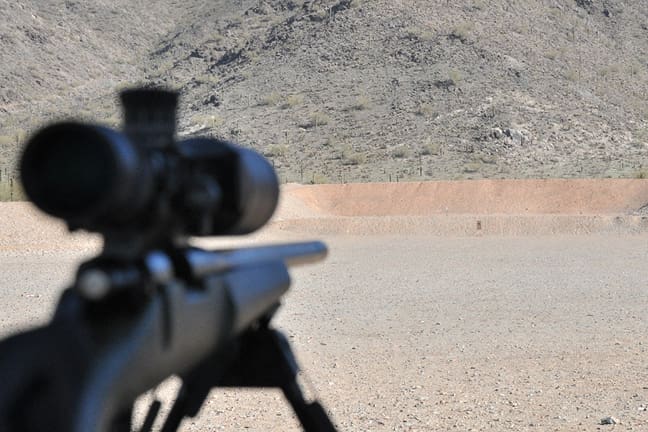 Look close – a cardboard target at 200-yards and teeny white IPSC target at 300-yards
Look close – a cardboard target at 200-yards and teeny white IPSC target at 300-yards
When I made it back to the firing line, I pulled out the heavy-duty moving blanket that I use for prone shooting and got down on the floor. I wanted to use up the worst-grouping rounds, but I ended up shooting almost all of the ammo I had left. Shooting steel is just plain fun, what else can I say? I did make sure, though, that I saved at least two rounds from each box so I can take some measurements. I promised myself that I was going to start reloading this year, so I’ll use these loads as a starting point.
You still reading this?
Overall, I’m really happy with the TLR. It’s obvious — as with any rifle — she likes certain types of ammo over others. The Remington MatchKings showed an amazing 0.32-inch grouping at 100 yards, but left a bit to be desired at longer ranges. The Federal GMM rounds showed ho-hum accuracy at 100 yards, but started to shine at 200-yards (0.94 inches) and my Dope Check at 300 yards showed a 2-shot grouping of less than an inch.
After seeing the 200- and 300-yard targets, I wish I had more than one box of the Federal GMM. I guess a re-shoot will have to wait a few weeks. With any luck, I’ll suck it up and buy my own reloading equipment and start reloading ASAP. Did I mention shooting steel at 300 yards is fun? With bore sighting and this set of testing, this gun has a total of 150 rounds down range so far.
The 40X trigger is smooth, crisp and, to be honest, awfully impressive for a factory supplied unit. After this review, I’ll probably tune it down a bit to see how it feels. I like the fact that it can be easily adjusted without taking the stock off, needing only a small flat head screwdriver. There’s no stacking, no over-travel or zero creep. My only complaint would be the actual trigger shoe itself. I prefer smooth triggers on tactical, target, and varmint rifles. The trigger on the TLR is grooved and in my opinion is better suited for use on a hunting rifle. Of course, this isn’t anything I can’t fix with a little bit of work.
Contrary to what some gun forum pages have said (or speculated), the barrel is free-floated all the way to the action. The B&C stock is very stiff and does NOT touch the barrel when using a bipod — obviously Remington wouldn’t do something that silly (would they?) The R3 recoil pad is fantastic and turns recoil into a very manageable “push.”
There are a few other things that I wish Remington would change. I’ve always liked Bell & Carlson stocks, but I wish Remington would have gone with B&C’s adjustable comb tactical stock instead. After all, Remington already uses this stock on their Target Tactical model. Unfortunately, the Target Tactical model isn’t stainless (something I wanted), and has that odd V-shaped VTR barrel — something I certainly didn’t want.
Before testing, I slipped on a buttstock cheek-riser to help, but I would have liked some more height in the comb. The TLR has a 26-inch barrel, no sights, and is marketed as a “tactical” model — it’s obvious that customers are going to put on some big glass.
Brownell’s sells the B&C stock that Remington should have installed in the first place. If I decide to replace the stock, I’m not sure which one I’d go with. As I said, the B&C stock feels great and an adjustable comb would help, but for the money I may end up going with an AICS 1.5 setup.
By using the AICS 1.5, I would not only get the adjustable comb, but it would also address my second complaint of this rifle. I am a big guy and although I have great dexterity, I’m no piano player. I hate loading short-action rounds into the gun from the top. Long-action guns, like my 7mm Rem Mag, .300 Win Mag, and .270 Win are much, much easier to load. The larger opening allows me to pointer- and middle-finger a round into the action to “push” it down into the magazine well.
With short action guns like the .223 and .308, I just don’t have that luxury. Remington should have installed a quality removable box magazine, such as Badger Ordnance or Wyatt’s setup. This would make reloads faster and easier — certainly a “tactical” advantage. If I did end up with the B&C varmint stock, a Badger Ordnance trigger guard and some magazines are certainly a requirement.
Some will argue that these upgrades would put the TLR above a certain price point and would limit sales. I say BS — how many price shoppers are weighing options with a $1,500 MSRP rifle? The answer is not many, and I’d argue that these additions would actually draw more customers to the TLR series. Take a quick glance through various forums and you can see the dozens of shooters who purchased an LTR rifle and immediately dropped it into an aftermarket stock and added a detachable magazine. The TLR should have been the rifle that LTR shooters wanted in the first place.
Specifications
Brand: Remington Arms
Model: XCR Tactical Long Range
Action: Bolt-action
Caliber: .308 Winchester (Also available in .223 Remington and .300 Winchester Magnum)
Sights: No sights, pre-drilled for scope base
Barrel Length: 26-inches, fluted, 1:12” twist, Black TriNyte Corrosion Control System over 416 stainless steel
O/A Length: 43.75 inches
Weight: 8.5 lbs (no scope, bases, or rings)
Other Features: X-Mark Pro adjustable trigger, hinged floorplate magazine, dual front swivel studs and rear stud
MSRP: $1,510 (street price: $1,200)
Ratings (out of five stars)
Style * * * *
The OD/black-web stock looks sharp, especially when combined with that long 26-inch fluted barrel. The bolt is jeweled and then blackened, adding a bit of class. It looks impressive to most that see it and certainly caught my attention when I first laid eyes on it.
Ergonomics * * * *
Everyone’s face is different, but I wanted more height on the comb. This gun demands big glass and Remington should set it up for that. However, the stock is solid and has a generous LOP. The “grip” of the webbing actually does help and the thumbhook is great for bag or off-hand use.
Reliability * * * * *
It’s a bolt-action rifle. So all types of ammo and not a single hiccup. The barrel cleans easily with minimal scrubbing and solvent usage. The stainless construction means this gun will hold up in extremely wet weather.
Customizable * * * * *
Well, it is still a Remington 700 so the sky’s the limit when it comes to customizing. This model’s decked out more than, say, an SPS Varmint gun, but still has some room for customization if you choose to do so.
Overall Rating * * * *
Once you finalize a handload, the Remington 700 XCR Tactical will undoubtedly hold sub-MOA groupings all day long. Add an adjustable comb stock and detachable magazine and I’ll add that 5th star.

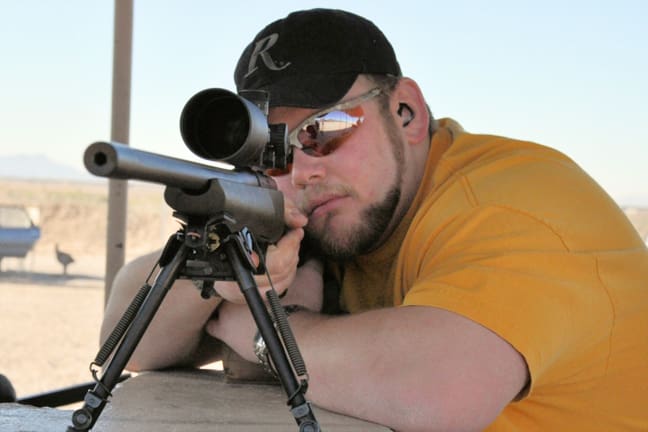



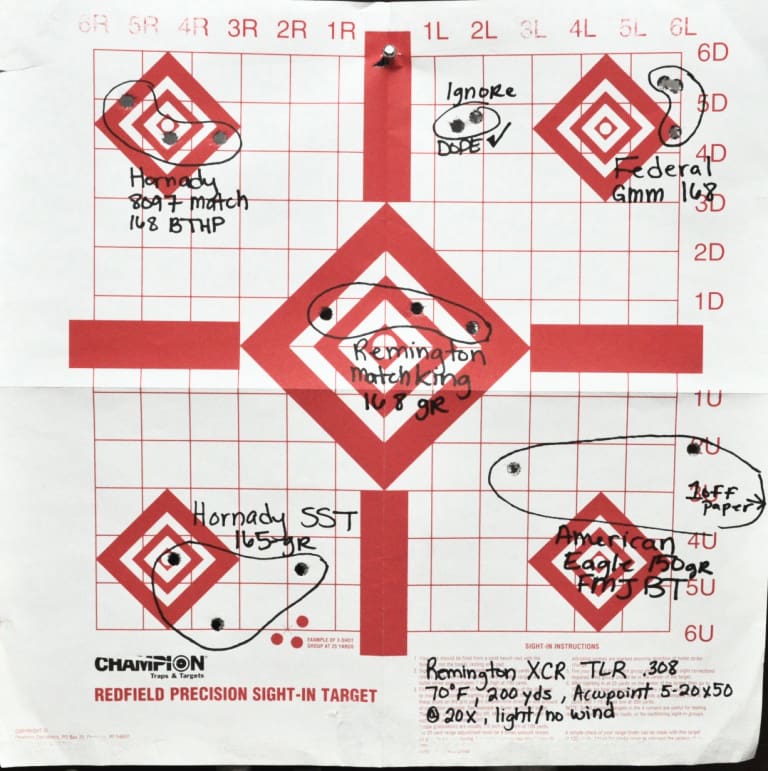
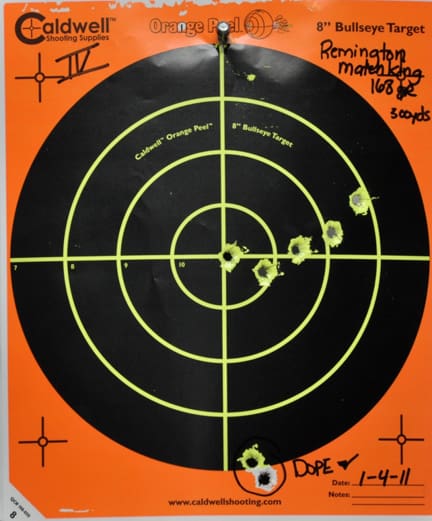




How many FPS does the 26″ buy you over a 22″?
Depends on bullet weight and powder used, although the longer barrel in the TLR (and most long-range rifles) isn’t just to get a faster FPS rate…
When talking with many 600+ yard guys, the general concensus was the ideal .308 barrel length was 22-24″. The 20″ barrels require faster burning powders to attain optimum velocities. Unfortunately, faster powders don’t typically lend well to very repeatable velocities (i.e. the standard deviation can be quite high). The 26″ barrel is “overkill” for most powders and loadings. However, even though overall FPS may not be much higher, the round-to-round velocity variances will be much smaller. Like I said, I’m going to start reloading and will work up a good hand load for this rifle. I may then have the barrel trimmed and threaded to 22-24″ and see how she shoots afterward.
Very interesting, thanks.
My 700 LTR build with Burris XTR 312 and US Optics rings and 20 MOA base loves Hornady Superperformance Match 178 gr OTM. It shoots at 2735-2750 fps, and is sub MOA at 200 yards – but prints 1-2″ higher than other loads because it shoots flatter. The LTR likes the Federal 168 Gold Metal Match also. Not sure what the velocity would be out of a 26″ tube, but I’d give that a shot. I’ll take it to 1000 yards after I get moved…
@Accur81 – I have ordered a few more boxes of FGMM 168 and 175-gr. I want to reshoot the 100-yard 168-gr again. I have a hard time believing that I couldn’t get under 1-MOA at 100-yards, but was able to shoot 1/2-MOA at 200-yards.There were some distractions at the range – mainly the guys practicing silhouette shooting. They were spotting each other and were yelling “HIT” and “MISS” at volumes normally reserved for rock concerts. I can’t blame my Federal groupings on that because they were doing that before I arrived and still by the time I left. In theory, every group had the “yell” factory taken into account.
Patrick – fair review. I have this gun in .308 and consistently get 0.7 MOA at 300 yards with Federal GMM, 168 g rounds. The rifle is, for the price, an absolutely excellent long range platform – I get first round hits at 1100 yards, 50% of the time on a standard IPSC plate. I agree with the adjustable cheek piece comment – I would not own a long-range gun without one. If you’re thinking about this gun, spend the $75 and get one.
I was at the gun store the other day and held one of these. The guy called it “The police model, why you ask? Because its heavy, its designed to be shot from a fixed or prone position. Its much to heavy to hump around while hunting.” He rolled into showing me a Remington 700 sporting model. Much lighter.
@Jwhite – this rifle can be used for hunting, but is better suited to ridge hunting. I certainly wouldn’t want to stalk or hunt from a tree-stand with this rifle. The long, heavy barrel makes the gun “front heavy”, but it balances well on a bipod or sandbag and it is stable when you’re on target. If I get drawn for elk this year, I may bring it along instead of my 7mm Rem Mag just to see how she does.
BTW – This isn’t the 700 Police model (aka 700P) and there are quite a few differences.
And?
The Federal GMM rounds showed ho-hum accuracy at 100 yards, but started to shine at 200-yards (0.94”) and my Dope Check at 300-yards showed a 2-shot grouping of less than an inch.
Does this ammo actually get better, MOA-wise, as the distance increases? How could that be?
@Chaz – sorry for the potentially confusing wording. With the FGMM, the 100-yard grouping was ho-hum and the 200 and 300-yard shots were tight. It defies the laws of physics for groups to “tighten” at a farther distances. Unless of course you’re in Hollywood… 🙂 I like to shoot 3 or 4 groups of five-shots to “see” how well a round or loading shoots. I only had enough ammo to shoot one group at each distance. I have ordered some more, as well as 175-gr FGMM to test… man it’s time to start reloading!
In case others wondered, what I meant by “started to shine” was that it outshot the Remington MatchKing and Hornady ammo – something I was honestly expecting at the 100-yard line. I didn’t mean that the groups magically tightened mid-air past the 100-yard line.
Never tried any Winchester ammo in it? Hmmm, somebody has issues?
@Jim D – I love Winchester ammo but they are far from producing a superior match-grade round. WWB for pistols – FGMM/Hornady/MatchKings for precision rifle work.
great article patrick you write very well.your shooting was on the money.do you think about entering a tornament.your getting very good .keep on blasting away.ps we need to get mom at the range.put a pic of me 1000 yards she will hit the center all the time lol
Patrick, thanks for the reply. 10x on the Winchester Match comments, a very good article. Please continue to contribute!
I bought one in 300 Win Mag (1:10″ twist rate) a couple of years ago. Topped it with a Nikon Monarch 4-14 X 42 mill dot scope. I would have to say that so I am dissappointed at the accuracy I have obtained. I have fired some factory loads in addition to several hand loads and have never ben able to achieve that MOA or less accuracy. I’m still doing load development, and feel that someday I will stumble on all of the components that come together to make this a tack driver. Based on the gun, I believe the potential is there, but have not seen it yet.
@Wes – What loads and weights have your tried? A range acquaintance of mine has a Sendero II (I droll over this gun) in .300 Win Mag and has much success with Winchester Supreme Accubond 180gr rounds. I’m not sure what twist-rate his rifle has, but I am fairly certain that it is also has the 1-10″ that yours does.
With me at the helm, I was able to squeeze a 3-shot 1-1/8″ group. Not fantastic, but this is factory loaded hunting ammo in a magnum chambering. The 1-10″ twist rate should be able to stabilize the heaviest of rounds, so if you are reloading some more I’d try some 200+ grain BTHP rounds, such as the SMK, Noslers, or V-Max bullets.
Please update us if you do some more testing!
Patrick,
Great writing, I am interested in purchasing the LR or Compact. I will be shooting 600 yds and less. Which would you recomend? What height rings did you use? Thanks!
@Dario – you can’t go wrong either way. I’m getting about 100-150 fps faster speeds out of my 26″ barrel than the 20″ .308 I have. At 600 yards the drop from either barrel is close enough that you should have plenty of adjustment in any quality “tactical” scope, therefore I would go with whatever you prefer. If it were me, it would be the Long Range model. Every one wants a short “tacticool” barrel until they don’t. I picked up a gently used AAC-SD .308 (20″ barrel) b/c I want to run a AAC 7.62 SDN, the barrel has a 1-10″ twist, and is already threaded. Some shooters, even some well respected “rifle houses”, say that a shorter barrel is more accurate than a longer barrel because it has a better “resonance ratio”. I call this B.S. b/c proper load development (I use the OCW method) will get you (hopefully) in the peak of a harmonic cycle and will negate any ill-effects of breech-to-muzzle pressure wave resonance. I do agree that shorter barrels (say a 18-20″) can be just as accurate as longer barrels. However, longer barrels have the benefit of faster velocity (typically) and that makes it easier to shoot more accurately (notice I said shooting more accurately, not “more accurate”). Good luck with whatever you choose!
@Patrick – I have done some further reloading and testing of my .300 Win Mag and I am very pleased with what I have found. My gun seems to like the heavier bullets. I have gotten some very good results recently in my 100 yard tests. I shot a 0.483 three shot group with 71.0 grs of IMR 4831 using Sierra 190 gr match kings. I then tried some 210 gr Berger VLD hunting bullets with 68.0 gr of Reloader 22. These had three shot groups of 0.618 and another one of 0.241. Needless to say that I am liking my gun much better now. Now that I can keep groups under an inch at 100 yards I will start to see what happens at longer distances.
@ Patrick. Great article. I have the .300 win mag version of this rifle and have had great luck with it. Great 1000 yard gun for sure.
@ Wes. I have had the same issues with mine. The recipe I have found is A-Max 168 being pushed by 81.5 grains of H1000. It took a while to get there but 82 grains of powder is 100% loading capacity and that seems to work well staying close to that amount. Also I spent a good while checking seating depth and settled on a shallow seating. If I remember correctly something like .468 is seating depth. It makes for a longer bullet but it will still fit in the magazine compartment.
Thanks for the great article. I’ve been debating about this or the 700p and have just about decided this is the rifle to get into long range shooting with. I only hope I can do as well as you in my quest for the right ammo. The hour later and sore shoulder sound great. I especially liked your notes on the Trijicon scope. I’d planned on the Leupold Mark 4 but I might just reevaluate since I’ve got an ACOG on an M4 and really like it. I couldn’t find the Harris HBRS model, the closest was the SBR 6″ – 9″. Is that the one?
Again, many thanks for a real informative article!
I love your site and I believed I’d personally share the corporation I personally use to acquire many traffic. I am delighted with the guests i always receive using their service and An excellent opportunity these to any webmaster.
Hi Guys!
You guys are a spoilt lot! You have everything at your disposal and still a lot of you guys are complaining and still just want to change everything on a superb rifle/s.
I can assure you guys I have a TLR and a XCR in a 308 calibre. A Sendero in a 300 win mag. G man those rifles shoot the shit out of anything. I also have a Savage 10BA (308) and really I just love it. It is accurate much more than me. I just do not miss with my rifles, but first I must do my part.
Just do a bit of homework, reloading, training and accept the fact that most rifles in this class is inherently much more accurate than the shooter himself.
Why everybody is now 1000 yard crazy, blows my mind. Practise to shoot straight, and so you could tap out all the potential out of that rifle of yours. Practise, practise and practise even more!
Whey back, I have done a snipers course with Israelis and the Germans. I have seen and experience it myself, people tend to think that brand names will make you the best. The more you spend the better you will do. Bullshit!! First sort your self out and then you will appreciate what you do have and make that work!
I hunt with what I have and I can tell you, I will shoot the shit out of most of you guys, even with all that mods. and extras you guys put on and spend a fortune on. Good for business!
Appreciate the fantastic products you do have available and use them. I promise you I am not a target shooter I am mainly a hunter and when I do practice I also challenged myself up to 800 meters mark.
Not on a range but in the field. I used a range finder that is all and I put my trust in my rifles and ammo.
I then tried everything possible to focus and do my part. I just don’t miss. I had put together some amazing shots at some not so friendly targets whey back then. I can promise you not one of them could argue against that then and now.Practise and practise some more. Built confidence in yourself and with your rifle and remember always point your firearms at the bad guys. Be a good man.
Cheers
Delta Mike
I am wondering how much improvement you got when you adjusted the trigger pull. I never could shoot good with a heavy trigger. A 2lb. trigger cuts the length of time Im squeezing by a forth and less time of moving anything around once Im on the bull.
l just picked up what appears to be a XCR Tactical Long Range in 300 Win mag. It’s got the stock, the trigger and the fluted barrel but the bolt isn’t done in the nitrate finish nor does the receiver say “tactical”. The serial # reflects a 2006 manufacture date. I wonder if Remington released some XCR Tactical long range models as prototypes before officially coming out with the model.
Haven’t yet shot it. Awaiting for the scope rings.
Any ideas what I have?. I can’t imagine an individual buying a 700 and then adding a new fluted barrel and Bell & Carlson stock along with the target trigger.
Thanks!
John
Patrick,
Thanks for writing, great read. I recently purchased the Harris bi-pod and also the E. Arthur Brown S-Lever to replace the OEM but cannot seem to be able to remove the OEM off the bi-pod. Any assistance provided is much appreciated.
Comments are closed.